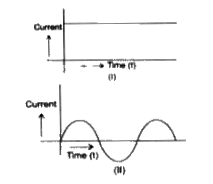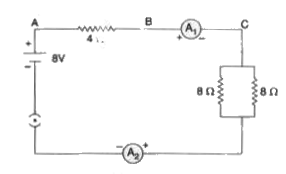Complete Solutions to TOPIC-2 ( Long Answer Type Questions ) of chapter ELECTRICITY of Class 10 book with complete answers and questions
| Class 10 | PHYSICS |
| Chapter | ELECTRICITY |
| OSWAAL PUBLICATION | TOPIC-2 ( Long Answer Type Questions ) |
| Number Of Questions | 29 |
| Academic Year | 2023-24 |
What is meant by electric current ? Name and define S.I. unil In a conductor electrons are flowing from B to A. What is the direction of conventional current ? Give justification for your answer. A steady current of 1 Ampere flows through a conductor. Calculate the number of electrons that flow through any section of conductor In 1 second. (Charge on electron ` 1.6 xx 10^(-19) C) `
06:33View SolutionWhat is meant by potential difference ? State its SI unit.
03:04View SolutionName a device that helps to maintain a potential difference across a conductor.
02:09View SolutionWhat is the lowest total resistance that can be secured by combinations of four coils of resistance `4Omega,8Omega,12Omega,24Omega`
02:55View SolutionEstablish a relationship to determine the equivalent resistance R of a combination of three resistors having resistances `R_(1), R_(2)` and `R_(3)` connected In series. Calculate the equivalent resistance of the combination of three resistors of `2 Omega, 3 Omega` and `6Omega` joined in parallel.
03:06View SolutionDerive an expression for Joule's law of heating.
05:57View SolutionGive two examples for applications of heating effect of electric current
02:27View Solution100 J of heat is produced each second in a 4 `Omega` resistor. Find the potential difference across the resistor.
02:53View SolutionA wire of resistivity p is pulled to double its length. What will be its new resistivity?
01:10View SolutionDraw a schematic diagram of a circuit consisting of a battery of three cells of 2V each, a 5`Omega` resistor, an `8Omega` resistor and a `12Omega` resistor, and a plug key, all connected in series.
02:22View SolutionTwo wires of equal length, one of copper and the other of manganin have the same resistance. Which wire is thicker ?
01:49View SolutionDerive an expression for the equivalent resistance of three resistors `R_(1) R_(2)` and `R_(3)` connected in series.
04:31View SolutionFuse of 3A, 5A and 10A are available. Calculate and select the fuse for operating electric iron of 1 kW power at 220 V line.
04:09View SolutionWhat is meant by the statement that the resistance of a wire is 1 `Omega` ?
03:02View SolutionTwo identical resistors each of resistance 12 `Omega` are connected (i) in series (ii) in parallel, to a battery of 6 V.
Calculate the ratio of power consumed in the combination of resistors in the two cases.03:36View SolutionHow is a voltmeter connected in the circuit to measure the potential difference between two points?
01:42View SolutionExplain the term : Heating effect of electric current.
03:27View SolutionDerive an expression for the heat produced by electric current and state Joule's Law.
05:03View SolutionWhy are electric bulbs filled with chemically inactive nitrogen or argon ?
02:32View SolutionState Ohm's law. Give mathematical relation between potentW difference (V), Current (I) and resistance (R) of a conductor . Draw an electric circuit for studying ohm's law.
03:53View SolutionWhen a 12 V battery is connected across an unknown resistor there is a current of 2.5 mA in the circuit. Find the value of the resistance of the resistor.
01:02View SolutionTwo wires X and Y are of equal length and have equal resistances. If the resistivity of X is more than that of Y which wire is thicker and why ? For the electric circuit given below calculate :

(i) Current in each resistor
(ii) Total current drawn from the battery and
(iii) Equivalent resistance of circuit08:08View SolutionStudy the following current time graphs from two different sources.

(i) Use above graphs to list word differences between the current in the two cases.
(ii) Name the type of current in two cases (iii) Identify one 1ource each for these currents.
(iii) What Is meant by the statement that uthe frequency of current in India is 50 Hz ?05:41View SolutionCalculate the resistance of the wire using the graph.
02:10View SolutionHow many `176Omega` resistors (in parallel) are required to carry 5A on a 220 V line ?
04:21View SolutionDefine electric power. Derive relation between power, potential difference and resistance.
02:20View SolutionDraw a labelled circuit diagram to study the relationship between the cunent (I) flowing through a conductor and the potential difference (V) applied acro its two ends. State the formula conelatlng the I in a conductor and the V acroa it. Also show their relationship by drawing a diagram.
What would be the resistance of a resistor if the current flowing through it is 0.15 A when the potential difference across it is 1.05 V ?03:58View SolutionFind out the following in the electric circuit given in the figure.
(i) Effective resistance of two 8` Omega` resistors In the combination
(ii) Current flowing through 4` Omega` resistor
(iii) Potential difference across 4`Omega` resistor
(iv) Power dissipated in 4`Omega` resistor
(v) Difference in reading of ammeter `A_(1)` and `A_(2)` ( if any) .
 07:55View Solution
07:55View SolutionTwo conductors A and B of resistances 5 `Omega` and 10 `Omega` respectively are first joined in parallel and then in series. In each case the voltage applied is 20 V.
(i) Draw the circuit diagram to show the combination of these conducton in each case.
(ii) In which combination will the voltage across the conductors A and B be the same ?
(iii) In which arrangement will the current through A and B be the same ?
(iv) Calculate the equivalent resistance for each arrangement.08:49View Solution
TOPIC-2 ( Long Answer Type Questions ) questions and complete solutions for chapter ELECTRICITY of OSWAAL PHYSICS (KANNADA ENGLISH) of Class 10
All Exercises from OSWAAL PUBLICATION Class 10 PHYSICS ELECTRICITY
- NCERT CORNER ( Intext Questions )
- Textbook Exercises
- TOPIC -1 (Match the Column )
- TOPIC -1 (Multiple Choice Questions )
- TOPIC-1 (Very Short Answer Type Questions )
- TOPIC-1 (Long Answer Type Questions )
- TOPIC-1 (Short Answer Type Questions -I)
- TOPIC-1 (Short Answer Type Questions -II)
- TOPIC-2 ( Long Answer Type Questions )
- TOPIC-2 ( Match the Column)
- TOPIC-2 ( Multiple Choice Questions )
- TOPIC-2 ( Short Answer Type Questions -I )
- TOPIC-2 ( Short Answer Type Questions -II )
- TOPIC-2 ( Very Short Answer Type Questions )
